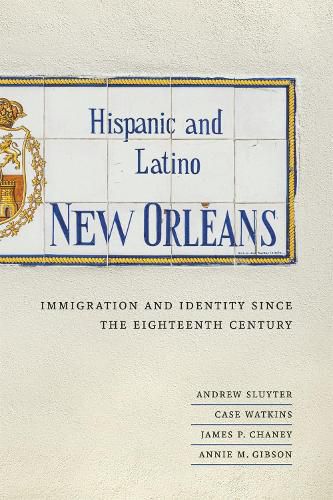Readings Newsletter
Become a Readings Member to make your shopping experience even easier.
Sign in or sign up for free!
You’re not far away from qualifying for FREE standard shipping within Australia
You’ve qualified for FREE standard shipping within Australia
The cart is loading…






This title is printed to order. This book may have been self-published. If so, we cannot guarantee the quality of the content. In the main most books will have gone through the editing process however some may not. We therefore suggest that you be aware of this before ordering this book. If in doubt check either the author or publisher’s details as we are unable to accept any returns unless they are faulty. Please contact us if you have any questions.
Often overlooked in historic studies of New Orleans, the city’s Hispanic and Latino populations have contributed significantly to its development. Hispanic and Latino New Orleans offers the first scholarly study of these communities in the Crescent City. This trailblazing volume not only explores the evolving role of Hispanics and Latinos in shaping the city’s unique cultural identity but also reveals how their history informs the ongoing national debate about immigration.As early as the eighteenth century, the Spanish government used incentives of land and money to encourage Spaniards from other regions of the empire - particularly the Canary Islands - to settle in and around New Orleans. Though immigration from Spain declined markedly in the wake of the Louisiana Purchase, the city quickly became the gateway between the United States and the emerging independent republics of Latin America. The burgeoning trade in coffee, sugar, and bananas attracted Cuban and Honduran immigrants to New Orleans, while smaller communities of Hispanics and Latinos from countries such as Mexico, Puerto Rico, and Brazil also made their marks on the landscapes and neighborhoods of the city, particularly in the aftermath of Hurricane Katrina.
Combining accessible historical narrative, interviews, and maps that illustrate changing residential geographies, Hispanic and Latino New Orleans is a landmark study of the political, economic, and cultural networks that produced these diverse communities in one of the country’s most distinctive cities.
$9.00 standard shipping within Australia
FREE standard shipping within Australia for orders over $100.00
Express & International shipping calculated at checkout
This title is printed to order. This book may have been self-published. If so, we cannot guarantee the quality of the content. In the main most books will have gone through the editing process however some may not. We therefore suggest that you be aware of this before ordering this book. If in doubt check either the author or publisher’s details as we are unable to accept any returns unless they are faulty. Please contact us if you have any questions.
Often overlooked in historic studies of New Orleans, the city’s Hispanic and Latino populations have contributed significantly to its development. Hispanic and Latino New Orleans offers the first scholarly study of these communities in the Crescent City. This trailblazing volume not only explores the evolving role of Hispanics and Latinos in shaping the city’s unique cultural identity but also reveals how their history informs the ongoing national debate about immigration.As early as the eighteenth century, the Spanish government used incentives of land and money to encourage Spaniards from other regions of the empire - particularly the Canary Islands - to settle in and around New Orleans. Though immigration from Spain declined markedly in the wake of the Louisiana Purchase, the city quickly became the gateway between the United States and the emerging independent republics of Latin America. The burgeoning trade in coffee, sugar, and bananas attracted Cuban and Honduran immigrants to New Orleans, while smaller communities of Hispanics and Latinos from countries such as Mexico, Puerto Rico, and Brazil also made their marks on the landscapes and neighborhoods of the city, particularly in the aftermath of Hurricane Katrina.
Combining accessible historical narrative, interviews, and maps that illustrate changing residential geographies, Hispanic and Latino New Orleans is a landmark study of the political, economic, and cultural networks that produced these diverse communities in one of the country’s most distinctive cities.